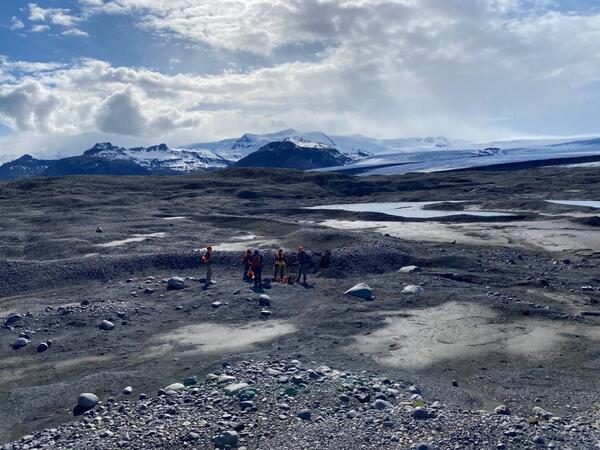Lunar Reconnaissance Orbiter Camera (LROC) mosaic of the Gruithuisen (pronounced “groot-high-sen”) domes on the Moon. These unusual high-silica volcanic features are the target of the NASA Lunar Vulkan Imaging Spectroscopy Explorer (Lunar-VISE) mission. USGS scientist Kristen Bennett is a member of the Lunar-VISE science team.
Kristen Bennett, PhD
Kristen Bennett is a planetary scientist who studies the geology of the Moon and Mars using NASA spacecraft.
Kristen Bennett is a Research Space Scientist at the Astrogeology Science Center in Flagstaff, AZ. Her research focuses on volcanism on the Moon and the sedimentary history of Mars. To conduct this work Kristen is part of NASA missions that obtain remote sensing data at the Moon and Mars and she conducts field work at terrestrial analogs on Earth. She primarily uses thermal, near-infrared, and visible remote sensing datasets to investigate planetary surfaces. Kristen is currently the Deputy PI of the Diviner Lunar Radiometer Experiment on Lunar Reconnaissance Orbiter. She led the Mars Science Laboratory Curiosity rover’s investigation in the clay-bearing Glen Torridon region, and she is a co-investigator on the Lunar-VISE payload suite that will land on the Moon to investigate a silicic volcanic feature in 2026. Previously Kristen has also worked on Mars Odyssey (THEMIS) and the Mars Exploration Rover (Opportunity). Kristen’s work on using terrestrial analogs to understand other planets includes field work in Iceland investigating glacial eskers to constrain the ancient Martian climate.
Professional Experience
2018 – present Research Space Scientist (USGS)
2016 – 2018 Postdoctoral Researcher (Northern Arizona University)
Education and Certifications
2016 Ph.D. Geological Science, Arizona State University
2011 B.S. Astrophysics, UCLA
Honors and Awards
2021 NASA Planetary Science Early Career Award
2021 Department of Interior Diversity Award
2020 USGS Diversity Award
Science and Products
Terrestrial Analogs for Research and Geologic Exploration Training (TARGET)

Lunar Reconnaissance Orbiter Camera (LROC) mosaic of the Gruithuisen (pronounced “groot-high-sen”) domes on the Moon. These unusual high-silica volcanic features are the target of the NASA Lunar Vulkan Imaging Spectroscopy Explorer (Lunar-VISE) mission. USGS scientist Kristen Bennett is a member of the Lunar-VISE science team.

Lauren Edgar, a research geologist with the USGS Astrogeology Science Center, uses a hand lens to identify minerals in a sample from a complex esker in Iceland.
Lauren Edgar, a research geologist with the USGS Astrogeology Science Center, uses a hand lens to identify minerals in a sample from a complex esker in Iceland.

Researchers from the USGS, NASA, and NAU gather around a small simple esker and ephemeral lake deposits.
linkResearchers from the USGS, NASA, and NAU gather around a small simple esker and ephemeral lake deposits. The team used sedimentology, geochemistry, and remote sensing to characterize these features on Earth before comparing them to Mars.
Researchers from the USGS, NASA, and NAU gather around a small simple esker and ephemeral lake deposits.
linkResearchers from the USGS, NASA, and NAU gather around a small simple esker and ephemeral lake deposits. The team used sedimentology, geochemistry, and remote sensing to characterize these features on Earth before comparing them to Mars.
A novel surface energy balance method for thermal inertia studies of terrestrial analogs
Relationship between explosive and effusive volcanism in the Montes Apenninus region of the Moon
Assessment of lunar resource exploration in 2022
Inclusive lunar exploration: Lunar Surface Science Workshop virtual session 13
Mars Science Laboratory CheMin data from the Glen Torridon region and the significance of lake-groundwater interactions in interpreting mineralogy and sedimentary history
Sedimentary organics in Glen Torridon, Gale Crater, Mars: Results from the SAM instrument suite and supporting laboratory analyses
Geology and stratigraphic correlation of the Murray and Carolyn Shoemaker formations across the Glen Torridon region, Gale crater, Mars
The distribution of clay minerals and their impact on diagenesis in Glen Torridon, Gale crater, Mars
The Curiosity Rover’s exploration of Glen Torridon, Gale crater, Mars: An overview of the campaign and scientific results
Orbital and in-situ investigation of periodic bedrock ridges in Glen Torridon, Gale Crater, Mars
Bedrock geochemistry and alteration history of the clay-bearing Glen Torridon region of Gale crater, Mars
Diagenesis of Vera Rubin ridge, Gale crater, Mars from Mastcam multispectral images
Science and Products
Terrestrial Analogs for Research and Geologic Exploration Training (TARGET)

Lunar Reconnaissance Orbiter Camera (LROC) mosaic of the Gruithuisen (pronounced “groot-high-sen”) domes on the Moon. These unusual high-silica volcanic features are the target of the NASA Lunar Vulkan Imaging Spectroscopy Explorer (Lunar-VISE) mission. USGS scientist Kristen Bennett is a member of the Lunar-VISE science team.
Lunar Reconnaissance Orbiter Camera (LROC) mosaic of the Gruithuisen (pronounced “groot-high-sen”) domes on the Moon. These unusual high-silica volcanic features are the target of the NASA Lunar Vulkan Imaging Spectroscopy Explorer (Lunar-VISE) mission. USGS scientist Kristen Bennett is a member of the Lunar-VISE science team.

Lauren Edgar, a research geologist with the USGS Astrogeology Science Center, uses a hand lens to identify minerals in a sample from a complex esker in Iceland.
Lauren Edgar, a research geologist with the USGS Astrogeology Science Center, uses a hand lens to identify minerals in a sample from a complex esker in Iceland.

Researchers from the USGS, NASA, and NAU gather around a small simple esker and ephemeral lake deposits.
linkResearchers from the USGS, NASA, and NAU gather around a small simple esker and ephemeral lake deposits. The team used sedimentology, geochemistry, and remote sensing to characterize these features on Earth before comparing them to Mars.
Researchers from the USGS, NASA, and NAU gather around a small simple esker and ephemeral lake deposits.
linkResearchers from the USGS, NASA, and NAU gather around a small simple esker and ephemeral lake deposits. The team used sedimentology, geochemistry, and remote sensing to characterize these features on Earth before comparing them to Mars.


